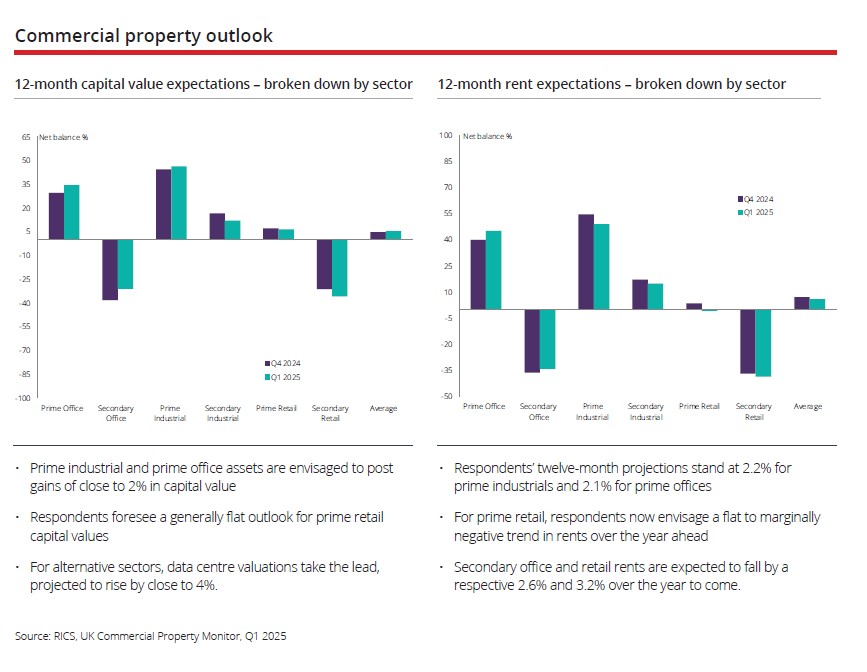
Commercial Property Market Review – July 2025
| City of London investment volumes are rising, with May hitting the highest deal count so far in 2025 | Owner-occupier demand is increasing as mortgage costs undercut commercial rents by up to 37% | Scottish commercial investment fell 20% in H1 2025, though hotels led performance and private buyers remained active |
City investment market outlook
The City of London investment market continues to show signs of recovery, according to property experts Savills.
May saw the highest number of monthly deals so far this year, with nine transactions worth a total of £181.9m. The largest deal in May was a £47.5m transaction from Whitbread, who plan to convert 87,000 sq. ft of office space into a 400-bedroom hotel on the South Bank.
At the end of May, the year-to-date volume was £1.62bn; although this is 24% lower than the five-year average, it is almost three times higher than 2024. Meanwhile, Savills’ City prime yield remains unchanged at 5.25% for the twenty-second consecutive month.
Market conditions look promising for the rest of the year, following the Bank of England cut to Bank Rate in May which should help boost momentum. There is also a growing quantity of available stock, £1.1bn of which is currently under offer.
More businesses buying their premises
It has become cheaper for businesses to buy their premises instead of renting, a trend which has positively impacted commercial market performance.
According to Rangewell, monthly mortgage payments can cost up to 37% less than commercial rents. Owning premises has therefore become an attractive concept, with businesses deciding to opt for stability and avoid rising rents. It also offers companies the opportunity to increase their overall assets. As a result, there has been an uptick in enquiries and completions for owner-occupier mortgages.
Overall, demand remained steady in Q2 when compared with the previous quarter. The leisure and hospitality sector saw growth of 0.7%. Meanwhile, the retail sector accounted for over a quarter (27.8%) of the listed properties already sold in Q2, closely followed by offices (27.3%) and industrial units (26.2%). Specialist subsectors are also making the move to owner-occupied premises, in particular dental care and children’s day nurseries.
A weaker H1 for Scottish commercial property
Analysis from Knight Frank shows that investment in the Scottish commercial property market decreased by 20% in H1 2025.
There was £750m of investment in the first six months of the year, notably lower than the five-year average of £925m. This decline is reflective of trends across the UK and is likely caused by geopolitical tensions and changing policies.
Hotels were the strongest performing asset class for the first time in recent years, with £213m worth of transactions, followed by retail (£207m) and offices (£152m). The most active buyers were private investors, accounting for 40% of transaction volumes, while international investors made up a third (32%) of investment.
Head of Scotland Commercial at Knight Frank, Alasdair Steele, commented, “In a volatile world, commercial property remains an attractive option for investors – and Scotland remains good value within the UK, which itself is widely seen as a safe haven from an international perspective.”

South East and Thames Valley office update
Research from Lambert Smith Hampton (LSH) shows Q1 take-up of offices in the South East hit a three-year high of 1.1 million sq. ft.
It is expected that Q2 will see an additional take-up of 900,000 sq. ft, which would make for the strongest six-month total since H2 2021. Leasing activity in the region has been boosted by resilient demand and limited supply of prime space. There has also been a resurgence of larger transactions, with 14 deals above 20,000 sq. ft between January and March. In the same period in 2024, there were only six of these larger deals.
Senior Director at LSH, Andrew Hodgkinson, noted that a lack of prime options has created “fresh opportunity for those brave enough to capitalise on this shortfall – especially in aspirational locations with infrastructure and affordability advantages, but a lack of prime supply, notable examples including Maidenhead, Milton Keynes and Woking.”
All details are correct at the time of writing (16 July 2025)
It is important to take professional advice before making any decision relating to your personal finances. Information within this document is based on our current understanding and can be subject to change without notice and the accuracy and completeness of the information cannot be guaranteed. It does not provide individual tailored investment advice and is for guidance only. Some rules may vary in different parts of the UK. We cannot assume legal liability for any errors or omissions it might contain. Levels and bases of, and reliefs from taxation are those currently applying or proposed and are subject to change; their value depends on the individual circumstances of the investor. No part of this document may be reproduced in any manner without prior permission
